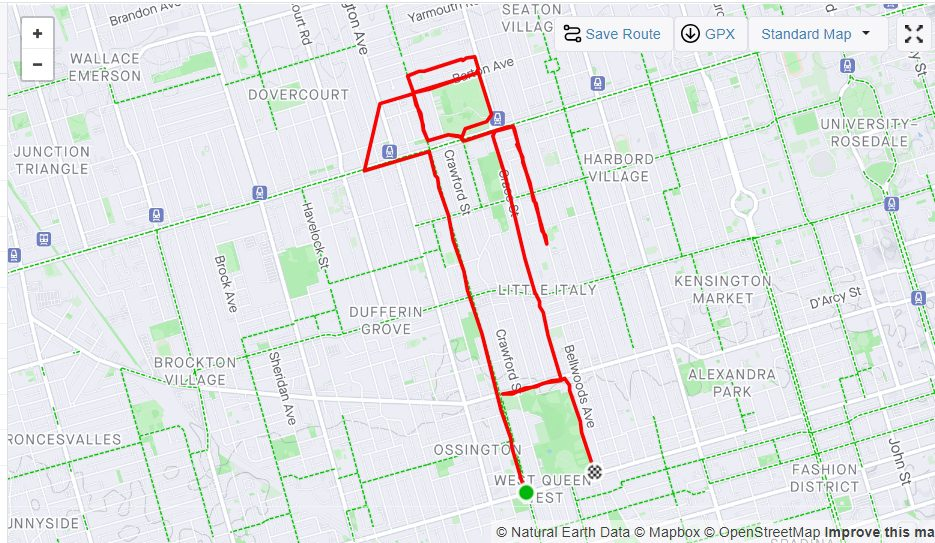A 32-year-old chartered accountant from Toronto has combined his passion for running and digital artistry into a breathtaking viral sensation. Duncan McCabe’s extraordinary feat of planning and executing meticulously mapped routes on Strava has turned heads worldwide.
By carefully designing his running paths to create a choreographed visual display, McCabe has pushed the boundaries of what is possible with GPS route tracking, blending art, technology, and endurance sports in an awe-inspiring project.
The Journey Behind the Dancing Stickman
McCabe’s ambitious project spanned 121 runs between January and October 2024, resulting in a stunning animation of a dancing stick figure set to Sofi Tukker’s energetic track, “Purple Hat.” Each run covered an average of 10 kilometers, culminating in a total distance of approximately 1,100 kilometers.
The visual masterpiece, stitched together from these individual routes, unfolds as a 30-second video that has captivated the internet, amassing over 25 million views and 407,000 likes on social media platforms.
The idea for the project didn’t emerge overnight. Inspired by notable Strava artists like San Francisco-based Lenny Maughan and fellow Torontonian Mike Scott—who famously created a giant beaver with his bike’s GPS route in 2022—McCabe saw an opportunity to push his creative and physical limits.
Read : Duncan Creates Dancing Stickman by Running Over 1100 Kms for a Year!!
His meticulous planning began in early January, with a critical milestone set early in the year: designing the iconic “hat” that would only make its appearance in the animation by July. McCabe’s foresight and attention to detail ensured that each run contributed seamlessly to the overall picture.
His commitment was unwavering. Despite facing the harsh realities of Toronto’s unpredictable weather, McCabe remained determined. “The same run, if I used 60 images, it would look very choppy,” he explained.
What an absolute legend!!
— Divya (@I_Madcap) November 23, 2024
Duncan made dancing stickman by running over 1100 kms for a year!!
Insta: dmcstrava pic.twitter.com/5Mnn2ZyP7M
“If you have a lot of frames, it looks fluid, so that was the motivation to keep doing it even in bad weather.” This dedication to smooth, lifelike motion underscores the artistry and discipline required for such a monumental task.
Crafting the Animation: Challenges and Triumphs
Creating GPS art of this complexity posed significant challenges. McCabe had to ensure that each route aligned perfectly with his planned design. Unlike traditional artists, he didn’t have the luxury of erasing mistakes or adjusting brush strokes. Every run had to be executed flawlessly to maintain the integrity of the final animation. Precision was paramount; even minor deviations could disrupt the entire sequence.
McCabe’s route planning involved breaking down the stick figure into individual “frames,” each corresponding to a separate run. Over the course of 10 months, he meticulously tracked his progress, refining his routes to ensure a seamless transition between frames.
The process was both physically demanding and mentally taxing, requiring not only endurance but also an exceptional level of concentration and spatial awareness.

His choice of Sofi Tukker’s “Purple Hat” added another layer of complexity. The upbeat, rhythmic track provided the perfect soundtrack for the dancing stickman but also set a high bar for synchronization. McCabe had to carefully pace his runs to ensure that the movements of the stick figure matched the tempo of the music, creating a harmonious blend of audio and visual elements.
Despite the challenges, McCabe’s project was a resounding success. The final animation is a testament to his skill and perseverance, showcasing fluid, lifelike movements that have captivated audiences worldwide. Social media users have praised his ingenuity and dedication, flooding the comments section with admiration and awe.
The Man Behind the Art: Duncan McCabe’s Journey
While McCabe’s Strava art has catapulted him into the spotlight, his professional background is equally impressive. An experienced finance professional from the Greater Toronto Area, McCabe currently serves as a Senior Finance Manager at PointClickCare.
His LinkedIn profile reveals a rich career history, with previous roles including Financial Reporting Manager at Canada Goose and positions at Henry’s, PwC in Australia and the UK, McMaster University, and the Canada Revenue Agency.
McCabe’s expertise lies in financial reporting, analysis, and management, with a strong focus on financial modeling and data analytics. His ability to balance a demanding career with his passion for running and digital artistry speaks volumes about his work ethic and dedication. It’s this same drive that fueled his ambitious Strava project, pushing him to complete 121 runs and cover 1,100 kilometers to bring his vision to life.

His journey also highlights the growing intersection between technology and physical activity. Strava, a popular route-tracking app, has become a platform for creative expression, enabling athletes to transform their runs and rides into works of art. McCabe’s project is a prime example of this trend, demonstrating how technology can be used to push the boundaries of what is possible.
McCabe’s success has also shone a spotlight on the broader Strava art community. Artists like Lenny Maughan and Mike Scott have paved the way, using GPS route tracking to create intricate designs and patterns. McCabe’s dancing stickman is a fitting tribute to their pioneering work, while also setting a new standard for creativity and precision.
A Viral Sensation and its Impact
The viral success of McCabe’s project has sparked widespread interest in Strava art, inspiring others to explore the creative potential of GPS route tracking.
Social media platforms have been abuzz with discussions about his work, with many users expressing amazement at the level of detail and effort involved. Some have even been inspired to embark on their own Strava art projects, using McCabe’s work as a source of motivation.
The project has also highlighted the power of perseverance and dedication. Completing 121 runs over the course of 10 months is no small feat, especially when each run must be executed with pinpoint precision.
McCabe’s story is a reminder that extraordinary achievements often require extraordinary effort, and that success is often the result of countless small steps taken consistently over time.

Beyond the realm of social media, McCabe’s project has broader implications for the way we think about art and technology. His work challenges traditional notions of what constitutes “art,” demonstrating that creativity can take many forms.
By combining running, technology, and digital editing, he has created a new form of artistic expression that resonates with a global audience.
As McCabe’s story continues to gain traction, it’s likely that we’ll see more athletes and artists experimenting with GPS route tracking. The success of his project has opened up new possibilities, encouraging others to explore the intersection of technology and physical activity. Whether it’s creating intricate designs or choreographed animations, the potential for Strava art is virtually limitless.
For McCabe, the journey is far from over. His dancing stickman is his second major project, following a similar creation in 2023. Given his track record, it’s safe to say that we can expect more innovative and ambitious projects in the future. As he continues to push the boundaries of what is possible with GPS route tracking, McCabe is likely to inspire a new generation of Strava artists.
In the meantime, his dancing stickman stands as a testament to the power of creativity, perseverance, and technology. It’s a reminder that art can be found in the most unexpected places, and that with enough dedication, even a simple running route can be transformed into something extraordinary.

